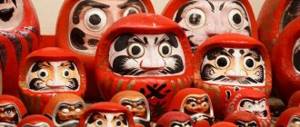Daruma doll. How to make a wish and have it come true!
Today I will not talk about the Japanese language or hieroglyphs. Today you will learn how to make wishes correctly so that they come true! On the eve of the New Year, I would like to tell you about how the Japanese make wishes. And the tumbler doll Daruma helps them fulfill their wishes.
Daruma is a traditional Japanese wishing doll. It is made by hand and leads straight to the fulfillment of the intended goal. This doll is made of wood, papier-mâché or paper and has no arms or legs. And another feature of this tumbler doll is that initially her eyes are drawn without pupils. You will ask why?
But because the Japanese use this doll to make wishes before the New Year! How? First, the doll's owner must make a wish, then draw a pupil in one of the doll's eyes. Also, the name of its owner is often written on the chin.
Daruma is kept in a visible place at home throughout the year. And, if the wish comes true by the next New Year, then a second eye is added to the doll.
And if the wish is not fulfilled, then they take it to the temple and burn it there and then buy a new one. Burning doesn't happen just like that. Burning a Daruma doll is a ritual of purification so that God (kami, kamisama) understands that the one who made this wish has not abandoned his goals, but is looking for other opportunities to achieve it.
This is a centuries-old tradition of Japan, a tradition that is very positive, motivating, with slight enthusiasm and everything else IT WORKS!
There are 5 main colors for dolls, according to which you should make wishes.
White color relates to desires for love and harmony; golden - about wealth and prosperity; yellow – about safety and security; purple – about health and longevity; red is about luck and happiness.
The most common color of daruma is red.
As soon as Daruma falls into your hands, you should do the following:
Step 1 – Determine the specific goal you intend to achieve.
Step 2 - Paint over one of the eyes (it doesn't matter whether it's left or right) to show your desire to achieve your goal.
Step 3 - Place the doll in a prominent place in the house so that while Daruma is focusing on your goal, you will not stop thinking about it and going towards it.
Step 4 – once the goal is achieved (and this is exactly what it will be), complete Daruma’s second eye, this way you say “Thank you!” to her!
Step 5 – Write the achieved goal on Daruma's back.
What's next? And then you need to buy a new Daruma doll and make your next wish come true!
Keep in mind that success comes only with clear and correct goal setting!
The key to success is a clear vision of what you want, a focus on results and determination that will not allow you to deviate from your plans.
Daruma is the embodiment of your specific goal. And at the same time, the doll is a reminder that once you have set out on the road to achieving your goal, you will never turn back! The wishes made must be measurable, that is, have a deadline for fulfillment. The ideal period for fulfilling a wish is 1 year.
Today you learned how the Japanese make wishes and what the Daruma doll is used for!
And now the task! Remember and write in the comments below whether your wishes that you made on New Year's Eve always came true or not? And do you believe that wishes made on New Year’s Eve always come true?
If you don't have a real Daruma doll, then draw one, make a wish, take a photo with your drawing and post it in the comments below! Everyone who posts their drawing with Daruma in the comments will receive a Japanese language bonus! By the way, here you can see how the participants in the competition for the best drawing drew a Daruma doll!
This is a useful read:
- Grammar of the Japanese language. Subordinate clauses with the conjunction 時/とき(currents)
- Japanese language. Japanese particles. The particle か/ka in Japanese.
- Unusual Japan
Tagged Daruma attractions of Japan Japanese life Japanese culture new year in Japan trip to Japan travel around Japan Japan Japanese culture
Five traditional toys
Japan is famous for its gaming platforms - Nintendo 3DS, Sony's Playstation 4 and others. However, there is also a long tradition of creating ordinary toys that have amused Japanese children for centuries. Here we will present five toys that have remained popular to this day.
Kendama
This is a Japanese version of the ballboke, in which the difficulty is increased by expanding the number of ways to catch the ball - in one of three cups of different sizes and on a pin at the end of the handle. The name comes from the words ken, "sword", and tama, "ball".
Karuta
There are many card games in Japan that have the word karuta in their name. Games intended for children usually use the Kana syllabary. One deck with pictures and letters is laid out on the floor, and on the other, on which poems or phrases are written, starting with this letter, what is written is read. The players sitting around the cards try to be the first to grab the card that matches the text they heard.
Kokeshi
These special Japanese dolls with a cylindrical body originate from the northeastern region of Tohoku. There are 10 main regional varieties of these dolls, some of which are associated with the hot spring resorts where they began to be sold. Their sleek, minimalist design attracts collectors.
Daruma otoshi
The monk Boddhidharma, considered the founder of Zen Buddhism, is known as Daruma in Japan, and his image is used in this game, the name of which translates as "Uroni Daruma." The rules are very simple - you need to use a hammer to knock out wooden blocks from under the Daruma, starting from the lowest one, but this in itself is not so easy, and if the column with the Daruma falls, the player loses. The video shows what a proper shot looks like in slow motion.
Hanetsuki
The game resembles badminton and is traditionally played by girls on New Year's Eve.
The game uses wooden hagoite boards and a shuttlecock. There is no net, and the participant who misses the shuttlecock is given a mark on her face with ink. According to an old belief, the longer the shuttlecock does not fall, the less mosquitoes will annoy the participants in the coming year. Photos:
Kendama
:
RambalacCaruta: Laura Tomàs AvellanaKokeshi: RaizoHanetsuki:
Banner photo: An engraving by Kikukawa Eishin, probably from the 1810s, showing a hagoita board and a shuttlecock for playing hanetsuki.
Rijksmuseum Amsterdam collection, source: . (Article in English published July 13, 2021)
Amatophobia
(Greek
amathos
- dust,
phobos
- fear) - obsessive fear, fear of dust.
Phobias of various origins accompany people everywhere, some of them are invisible to others and quietly doze, waiting for the right moment to suddenly appear from the dark depths of the subconscious and plunge a person into the abyss of dark and sticky fear. There are people who live with their fears for a long time, literally for years, and simply adapt to their fear, because phobias only bother them from time to time. For example, if a person is afraid of flying on an airplane, or cannot stand heights, then he simply avoids such situations, and life continues without various extreme situations associated with the phobia. There is a fear of swimming - so you don’t have to swim, but just take a shower in your comfortable and safe bathroom. But there are phobias when it is very difficult to avoid contact with the object or situation that causes them. For example, one of them is amatophobia. A person suffering from this fear is incredibly afraid of dust and various contaminants that look like dust. Ordinary house dust inevitably makes itself felt and occurs in various office and residential areas. It is inevitable even in the apartment of the cleanest housewife, who wages a persistent and regular struggle against this phenomenon. A person suffering from this phobia tries to constantly wet clean his home, and the vacuum cleaner is his best friend and ally. Behavior of amatophobes
A patient suffering from amatophobia tries in every possible way to avoid places where dust may accumulate.
If, while walking through the yard, he sees how a diligent housewife is knocking out a carpet on a special crossbar, and a noticeable column of dust rises from each blow, then he may not go home, since he does not want to get closer, and pass by, although the place is located in the distance. It seems to an amatophobe that as soon as he gets close, this terrible dust will completely cover him, like a swarm of angry bees, leaving no free space. It will stick disgustingly to the skin, causing the most terrible and irreparable consequences. It should be noted that, in fact, a large amount of dust does not make a person healthier and more beautiful, but, nevertheless, people who do not have such a phobia treat this phenomenon calmly, trying to avoid such places if possible, and limit themselves to the fact that They try to keep their houses clean. Causes of amatophobia
According to scientists, the source of any phobia lies in long-forgotten events that a person may not even remember, but they played their fatal role and became the starting point for the development of the phobia.
In some cases, psychologists argue that genetic predisposition and character traits of a person may be to blame for the occurrence of a phobia. And although there are phobias, the origin of which even specialists cannot determine, amatophobia still refers to those panic disorders that are associated with certain negative events. If we talk about childhood, then, probably, there is no such person who would not play hide and seek. Where do children most often hide? The classic option is a closet, but you can also crawl under the bed. This is exactly the place where the probability of finding dust is quite high. The baby could hide, huddled against the dusty floor in the dark, and suddenly become afraid of something. And this is not surprising, because he is alone, perhaps also in someone else’s house, where lumps of dust have formed in the corners under the bed, looking like strange little creatures... and to top it all, no one finds him for so long. But then the door opens, and a draft moves the dust bunnies as if they were alive... The situation may remind the child of the plot of a scary story, and now the prerequisites are ready for the very slow but reliable development of amatophobia. A special case is when this phobia occurs in people who live or who find themselves while traveling in difficult climatic conditions, where dust storms of varying intensity occur. A situation like this can frighten anyone, when columns of dust fly through the air, clogging the lungs, making it difficult to breathe and see. Needless to say, this is real stress for a child’s psyche, which can turn into a real phobia when the fear of dust is very strong. How amatophobia manifests itself
Amatophobia does not manifest itself in the same way, since, first of all, the character of a person, his habits, state of health, age, and many other factors matter.
But there are a number of symptoms that are mentioned during attacks of various panic fears. With amatophobia, one or two signs of the disease, or a whole set, can be observed. Seeing dust in any of its manifestations, an amatophobe can only feel excitement and try to leave this place as soon as possible, or eliminate the pollution or clean up. But this is in an easy case. If the phobia has a severe form, then a person experiences severe fear at the sight of dust, and even more so when it gets on his skin or clothes. There is a sharp change in heart rhythm, it becomes difficult to breathe, and the patient sweats. It may even seem that the person has simply lost his mind, as he looks like a madman during a panic attack. His body becomes uncontrollable and he may vomit violently and uncontrollably. It seems to a person that, along with the dust settling on him, toxic substances are falling onto his skin, which bring with them something very terrible, even death. How to treat amatophobia
There are only assumptions about the occurrence of phobic fears. But it is known that phobias are often accompanied by depression. Treatment consists of taking sedatives prescribed by a doctor. By contacting a qualified psychologist or psychotherapist, a person can receive help in the form of special training to help the patient cope with the situation. Regardless of the cause of the fear of dust, the main cure in treatment is the patient’s desire to get rid of his irrational fear. Modern clinics use innovative methods for treating phobias. This is hypnosis treatment, bioinformation therapy, and other methods. A few sessions are enough for the patient to feel improvement, and in some cases completely get rid of amatophobia.
Information sources:
psyportal.net - amatophobia (koniophobia);
enc-dic.com - amatophobia;
psychiatry.academic.ru - amatophobia.
edudic.ru - amatophobia - Explanatory dictionary.






